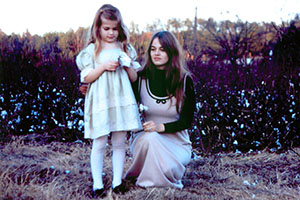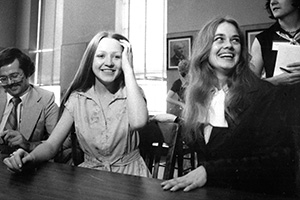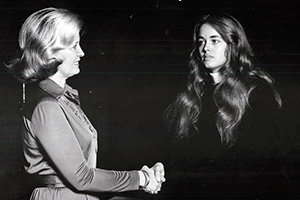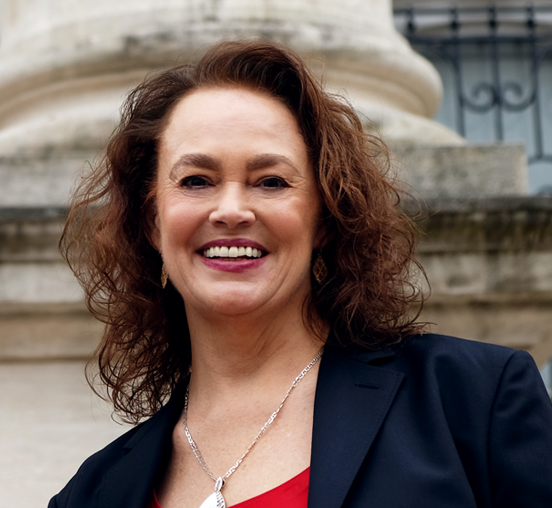
My journey in law began as a single parent in 1972 as one of the only women in law school. As I was the sole support for my child, night law school was my only option while I worked weekends as a server. Attending classes was always a challenge. One professor made comments that “females were not cut out for law as they are too emotional.” At one point, a supportive student and I filed a complaint with the Dean of the Law School as I was concerned my grades would be affected due to the discrimination. At that time, women at the school represented three percent of the class. After receiving my law degree with great pride, I knocked on the doors of every law firm in town only to be told to go home to raise my child. Facing roadblocks at every turn, I began fighting for gender equality in the practice of law.
Early Years in Practice
One day a young woman, Marla Pitchford, came to me for representation after other attorneys turned her away when she had no money to hire a lawyer. She likely approached me because I was the only female at that time practicing law in my community. This case evolved into a huge media event with the worldwide press. At the trial, news media throughout the country were present as I argued for my client, a victim herself, just like Hester Prynne in “The Scarlet Letter.” While women’s rights groups were upset with my pleading “temporary insanity,” I obtained an acquittal. This case launched my legal career with national notoriety. It also led to my appointment as Public Advocate, where I represented indigent clients as the first female attorney in Bowling Green, Kentucky to try a case before a jury.
My experience with judges came with mixed results. In one of my first court appearances, a judge brought me into his chambers and told me, “I do not allow blacks or women to practice law in my court.” I remember trembling as this was one of the first experiences in court as a young lawyer in a nearby rural county. I never returned to that courtroom since I feared reprisal with Bar Association complaints against me. Indeed, other attorneys used this tool to file frivolous complaints that have haunted me over the years. Eventually, my career path evolved into personal injury and semi-truck representation for those injured.

Breaking the Glass Ceiling in Law
In the past forty-five years, I witnessed women joining the ranks as attorneys. Today, students of all backgrounds and gender fill law schools.
However, the roadblocks have not crumbled completely. I still fight for female equality. In many cases, male partners head law firms with a token female attorney. Women are often not accepted as an equal in personal injury law and particular commercial litigation. At a deposition, the receptionist called me “Double Trouble.” Interestingly, my client was impressed since there is nothing better than an attorney who is “Double Trouble.” Other names surfaced, such as “Iron Pants,” and I received an email from a government attorney in a commercial case that I was “aggressive and coy” when fighting for the rights of my client.
Representing clients injured by commercial trucks remains a male-dominated field. Attending attorney seminars for trial litigation can be challenging. The most recent incident occurred when my husband accompanied me to a truck seminar. Attorneys shook my husband’s hand, assuming he was the lawyer in the family. This year I attended a trial seminar with few women attending where the speaker explained how to dress for trial, instructing us to “wear a coat and tie!” Amused, I approached the speaker and asked if I should also wear a tie?
Advantages for Female Lawyers
Despite the discrimination I faced over the years, there are tremendous advantages, particularly in the early years of being a female practicing law. If the larger firms accepted me during my first years of practice, I would have likely stayed and never struck out on my own. I would not have had the national notoriety from that first major case. I certainly would not have had the opportunity to gain valuable courtroom experience representing clients charged with multiple crimes. Being forced on my own in those early years was an advantage.

As many female attorneys know, clients often prefer a woman to represent them, particularly when it involves a catastrophic loss of a family member and injured children. Even in minor injury cases, people may feel more comfortable talking to a female attorney. It may be easier for us to show empathy and emotion with our clients. I can still understand the financial struggle inherent to most of my clients who come from backgrounds of poverty. The ability to empathize with my injured clients has been the cornerstone to the success of my practice.
Breaking the glass ceiling in the modern legal profession has been an immense challenge. While women have made tremendous gains since the 1970s, much remains to be done. Despite progress in the legal community, it is still a profession dominated by men as owners and partners in the business. Certain types of legal positions are likely to be dominated by men rather than women, such as personal injury attorneys who own their businesses and in-house general counsel who are partners. Female lawyers should know discrimination is prevalent in the legal field, particularly in the high-end personal injury practice, including commercial litigation. Challenging this glass ceiling with gender equality continues to be my passion.
Originally published by the Kentucky Justice Association.
